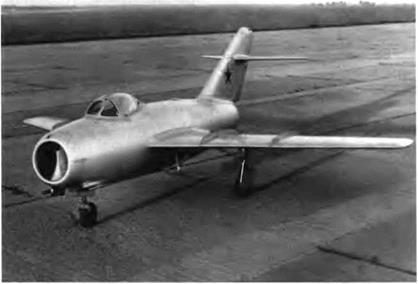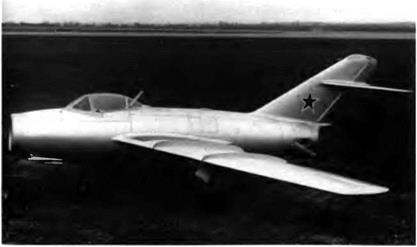MiG-15 /1310 / S-03
The S-03 prototype was built in March 1948 within the context of the test program. Nearly all of the shortcomings found in the first two prototypes were eliminated on the S-03 under the supervision of chief engineer A. A. Andreyev, who was in charge of the program. Like the S-02, the S-03 was powered by a Nene II. But it differed from the S-02 in many other respects:
—it was equipped with hydraulically powered airbrakes hinged on the fuselage tail section (the rear structure had to be strengthened for this purpose)
— the stabilizer was moved 150 millimeters (5.9 inches) aft to improve its efficiency (this change necessitated a modification of the tail fin)
—the elevator was fitted with balance weights —the canopy was attached by a new latch mechanism —capacity of the no. 1 and no. 3 fuel tanks was reduced, limiting total fuel capacity to 1,450 1 (383 US gallons) from 1,538 1 (406 US gallons)
—two store points were added beneath the wing for auxiliary fuel tanks or bombs (FAB-lOOs, FAB-50s, or AO-25s)
—removal of the cannon fairings was simplified —new equipment was introduced, from an ASP-IN gunsight and an S-13 camera gun to a fire extinguishing system
The most serious challenge to be met with the S-03 was giving the wing structure adequate strength to comply with 1947 standards. This is why the new V-95 alloy was widely used for the wing structure (in place of D-16 duralumin) and 30-KhGSA chromansil steel for the spar webs and flanges. This structural reinforcement added 180 kg (397 pounds) to the weight of the wing. There were twenty-three ribs instead of twenty, and the skin was 1.8 mm thick instead of 1.5 mm. The efficiency of the aileron was improved by increasing the area from 0.96 m2 (10.3 square feet) to 1.17 m2 (12.6 square feet). The span of the
|
|
The 1-310 S-03 was the master aircraft selected by the WS. But to be safe the air force also ordered a small number of La-15s, a competing fighter created by the Lavochkin OKB.
|
|
The S-03 was equipped with airbrakes hinged on the rear fuselage. Their modest area of 0.52 m2 (5.6 square feet) had to be increased on production aircraft.
flaps was reduced slightly, but their chord was increased. The gear, airbrakes, and flaps were controlled by the hydraulic system with a no – load running valve. Switching on no-load running was automatic.
The S-03 was the first MiG aircraft that used its flaps for takeoff. That reduced takeoff roll to 695 m (2,280 feet) from the S-02’s 810 m (2,655 feet). But the airbrakes reduced the landing roll by only 30-35 m (98-115 feet). The prototype left the factory in March 1948 and was first flown on 17 June by I. T. Ivashchenko. The factory tests ended on 15 October (LI1 test pilot S. N. Anokhin came to assist Ivashchenko). The S-03 made a total of forty-eight flights, and all its flaws were eradicated one after the other. During one of these flights it reached a top speed of Mach 0.934. On 1 November the S-03 was sent to Saki, in the Crimean branch of the GK Nil WS, for another series of tests carried out by two military pilots, Yu. A. Antipov and V. G. Ivanov. They made thirty-five flights and spent fifteen hours and twenty-one minutes in the air, wrapping up their examination on 3 December. On 23 December Marshall Vershinin, commander-in-chief of the WS, ratified the "acceptance trials report of the frontal MiG-15 single-seat fighter.” These are some of the report’s conclusions:
Considering its performance, we recommend choosing this aircraft to equip our squadrons, to prepare its series production and its availability for issue in compliance with the WS standards.
—this aircraft can be operated from rough strips — dogfight tests have not yet been carried out, but because of its high maneuverability it will be possible to involve the aircraft in fierce close combats —it can be flown inverted
—because of its handling characteristics, it can be flown by average pilots
The outstanding performance of the 1-310 S-03 (as well as the S-01 and S-02) in test flights was undoubtedly the reason that mass production was ordered by the Soviet government.
Specifications
Span, 10.085 m (33 ft 1 in); overall length, 10.102 m (33 ft 1.7 in); fuselage length, 8 125 m (26 ft 7.9 in); wheel track, 3.852 m (12 ft 7.6 in); wheel base, 3.075 m (10 ft 1.1 in); wing area, 20.6 m2 (221.7 sq ft); empty weight, 2,955 kg (6,513 lb); takeoff weight, 4,806 kg (10,592 lb); pilot, 97 kg (214 lb); fuel, 1,210 kg (2,667 lb); oil, 40 kg (90 lb); ammunition, 117 kg (258 lb); removable equipment, 35 kg (77 lb); wing loading, 233.3 kg/m2 (47.8 lb/sq ft); max operating limit load factor, 8.02.
Performance
Max speed, 1,031 km/h at 3,000 m (557 kt at 9,840 ft), 983 km/h at
10.0 m (531 kt at 33,800 ft); max speed at sea level, 905 km/h (489 kt); climb to 5,000 m (16,400 ft) in 2.3 min; to 10,000 m (32,800 ft) in 7.1 min, landing speed, 160 km/h (86 kt); service ceiling, 15,200 m (49,850 ft); range of S-03 at 1,000 m (3,280 ft), 660 km (410 mi); at
5.0 m (16,400 ft), 908 km (564 mi); at 12,000 m (39,360 ft), 1,433 km (890 mi); range of S-02 at 1,000 m (3,280 ft), 695 km (432 mi); at 5,000 m (16,400 ft), 955 km (593 mi); at 12,000 m (39,360 ft), 1,530 km (950 mi); takeoff roll, 695 m (2,280 ft); landing roll, 710 m (2,330 ft).












